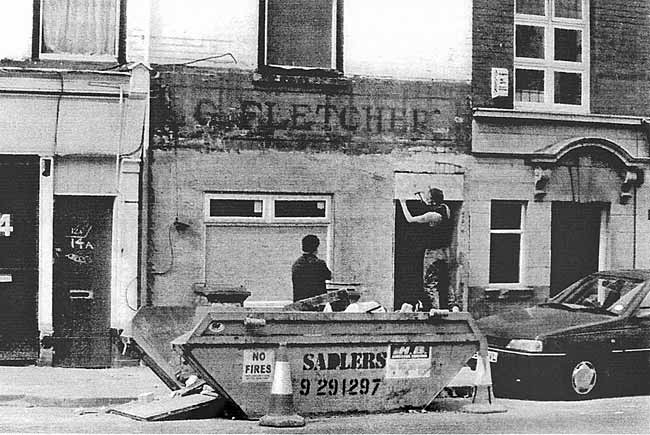< Previous
ONE MAN’S MEAT:
A Taste of Sneinton’s Past
By Stephen Best

A REMINDER OF THE PAST APPEARED in Sneinton Road during the spring of 2002, but is likely to vanish again very soon. Number 12, the empty shop next door to The Lamp public house, is currently being converted into flats, and the removal of the fascia board has disclosed the name of G. Fletcher, a former shopkeeper at this address. Painted directly on to the brickwork, the signwriting is excellent, with serif characters and a decorative outline round each letter, all within a painted surround. Fletcher's name recalls the lengthy association of 12 Sneinton Road with the retail butchery trade.
As long ago as 1854 there were no fewer than seven butchers trading in Sneinton Road, but the directory of 1874 is the first to record one next door to the Smith's Arms, as the pub was then, and for generations afterwards, named.
The shopkeeper concerned was Joseph Wainer, who remained in business here until at least 1885. Four years later Robert Ford had become proprietor of the butcher's at no. 12, but his stay was a brief one, as Alfred Checkland was in charge by 1893, continuing as owner until after 1901. The directory for 1905-06, however, reveals that Mrs Sarah Ann Checkland was in business, so we may assume that Alfred had died in the meantime.
The 1908 directory is the first to show George Fletcher in possession, and his stay at 12 Sneinton Road was to be a lengthy one. He continued to sell meat here until after 1941, and the sign lately exposed appears to date from the earlier part of his tenure of the shop.
By 1950 Fletcher had been supplanted by Geoffrey Watts, who was still the butcher in residence in Coronation Year, 1953. Three years later John Thomas Icke was carrying on the same trade at 12 Sneinton Road, and another Icke was in business at the same address at the end of that decade.
In these days, when so many shops seem to change hands bewilderingly quickly, and to move from one trade to another within a year or two, it may seem remarkable that one Sneinton premises should have remained in the same line of business for over eighty years at least.
Sneinton in general, and Sneinton Road in particular, were evidently able to sustain a considerable number of butchers’ shops. Of course, very few households owned a refrigerator before the 1950s, and supermarkets had not yet appeared in Nottingham. In the early years of the 20th century, and indeed until the refrigerator age, most people bought meat on the day they intended to cook it. A home-made meat safe in the cellar, or the cellar steps themselves, were usual storage places. My father, I remember, constructed an ingenious fly-proof meat container which shared one of our cellars with the coal.
In addition to the numerous local shops, butchers' stalls were, in the early part of the 20th century, found in Sneinton Market, and until the 1920s, in the Shambles under the old Exchange. After the demolition of the Exchange, some of these were relocated in the West End Meat Market (now West End Arcade) at the end of Long Row West, while a few moved to the Central Market.
George Fletcher, together with his forerunners and successors, evidently traded successfully in competition with the nearby shop of Edward A. Wilcock, whose well- remembered and rather picturesque butcher's shop stood back behind a courtyard at the foot of Sneinton Road. Wilcock's shop seems in retrospect so much a feature of Sneinton Road that it comes as a surprise to find that his address was, in fact, 8 Carlton Road.
In 1941, the last year in which we can be certain that Fletcher occupied the Sneinton Road shop, there were twenty butchers' shops active in Sneinton. There are very few now, and meat eaters who value their local butcher should remain faithful to him. As always, it's a case of 'Use him or lose him.’
< Previous
